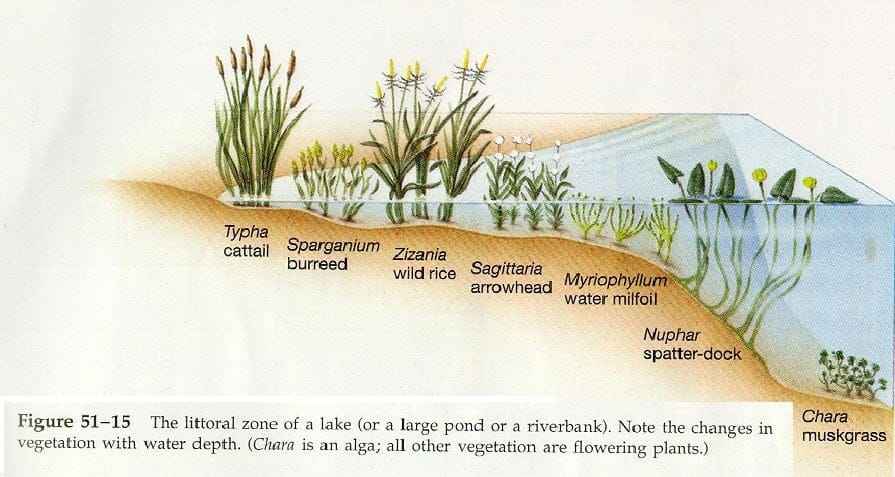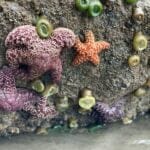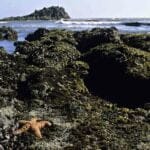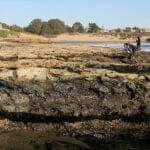Ever been curious about what’s hiding in the shallows where the ocean meets the land? This zone, called the littoral zone, is teeming with an incredible array of creatures that have figured out how to thrive in this ever-changing environment. From tiny creatures that you need a microscope to see to towering seaweeds and elusive marine animals, this area is a hub of life and diversity. Let’s dive in and explore the fascinating world that lies just beneath the surface.
Littoral Zone Organisms: Life on the Edge
Picture a beach vacation – the warm sand, the crashing waves, the salty air. Now, imagine the bustling world hidden just beneath the surface of those waves, where the ocean meets the land: the littoral zone. This shallow-water zone is a hotspot for life, a place where creatures have evolved incredible strategies to handle the ever-changing conditions.
Think about it – one minute these organisms are submerged in seawater, the next they’re baking under the sun. This is especially true in the intertidal area, where the tide goes in and out, demanding that resident organisms become masters of adaptation.
Always on the Move
To survive the constant changes in water level, some residents, like crabs and those little snails we often see clinging to rocks, are always on the move. They’ve become experts at seeking shelter under rocks or seaweed when the going gets tough. It’s like a game of hide-and-seek, but the stakes are high – it’s a matter of survival.
Digging Deep
Other organisms, like mud shrimp and marine worms, have evolved a different strategy to cope with the fluctuating conditions. They prefer to burrow into the sand or mud, finding safety and comfort in digging deep, away from the harsh elements and hungry predators.
A Cast of Characters
The littoral zone is like a bustling city, teeming with an incredible diversity of plants and animals. You might spot colorful sea anemones swaying in the current, their tentacles poised to snatch unsuspecting prey. Look closer and you might see a starfish slowly crawling across the ocean floor, or a sea cucumber burrowing through the sediment. And of course, no beach is complete without the scuttling of crabs and the occasional glimpse of a snail leaving its slimy trail.
Built to Survive
Each of these organisms has developed unique adaptations to thrive in this challenging habitat. The abalone, for instance, has that incredibly strong shell, a suit of armor that protects it from predators and the pounding waves. Anemones, with their stinging cells, aren’t as helpless as they look – they can deliver a powerful sting to defend themselves and capture prey. And let’s not forget about crustaceans like crabs, lobsters, and barnacles. Their hard exoskeletons and jointed legs give them both protection and incredible mobility.
A Delicate Balance
By studying these fascinating creatures, we’re not just satisfying our curiosity. Understanding how littoral zone organisms have adapted to their environment can give us clues about the overall health of our coastal ecosystems. As our climate changes and human activities increasingly impact these sensitive areas, this knowledge becomes even more crucial. The more we learn about the challenges these organisms face, the better equipped we are to protect them and ensure the continued health of our oceans.
What Kind of Organisms Live in the Littoral Zone?
The littoral zone, that narrow strip where the ocean meets the land, is anything but boring. It’s a whirlwind of activity, thanks in part to the ever-changing tides, crashing waves, and fluctuating salt levels. But that’s what makes it so fascinating! The organisms that call this place home are masters of adaptation, built to weather the constant change.
Think of it like a combination of a beach, a rocky shore, and a shallow underwater garden. You’ll find plants like tough seaweeds and algae clinging to rocks, their flexible bodies swaying with the currents. These hardy pioneers not only provide food for numerous creatures but also offer a safe haven from predators.
And speaking of creatures, the littoral zone is teeming with them! Imagine colorful fish darting in and out of seaweed forests, scuttling crabs searching for a tasty morsel, and snails clinging to rocks for dear life as waves crash around them. Don’t forget the echinoderms – those spiky stars and urchins you might find clinging to rocks, playing their part in the delicate balance of this ecosystem.
But the party doesn’t stop underwater. Look up, and you’ll probably spot shorebirds strutting their stuff on the sand, their beaks probing for a seafood snack. Gulls might be circling overhead, their cries adding to the symphony of the coast, while ducks and other waterfowl bob peacefully near the shore, searching for their own underwater meals.
The littoral zone isn’t just a fascinating spectacle; it’s a crucial part of our planet’s health. It’s like a giant filter, cleaning the water and providing a nursery for countless marine creatures. Scientists are still uncovering all of its secrets, studying how these amazing organisms thrive in such a dynamic environment. Who knows what other wonders we’ll discover as we continue to explore this vital and vibrant ecosystem?
What Microorganisms Are Found in the Littoral Zone?
The littoral zone is teeming with life, and not just the kind we can easily see. The microscopic world is buzzing with activity too! Let’s take a peek at the tiny but mighty microorganisms that call this place home.
A Microscopic Metropolis
Imagine a bustling city, but instead of skyscrapers, there are millions upon millions of bacteria, fungi, archaea, and protists – all just going about their day. You wouldn’t believe how much is happening under the surface! These minuscule life forms are like the behind-the-scenes crew of the littoral zone, keeping everything running smoothly.
Working Together for a Healthy Ecosystem
Don’t let their size fool you, these microbes are hard workers! They’re like the ultimate recyclers, breaking down dead plants and animals and turning them into nutrients that other organisms can use. Think of them as the cleanup crew, making sure nothing goes to waste. And that’s not all! Some microorganisms have formed incredible partnerships with larger creatures like invertebrates and fish. They help with digestion and provide essential nutrients, it’s a win-win for everyone!
Adapting to Change Like Champions
Living in the littoral zone isn’t always easy. Things are constantly changing – the tide comes in and out, temperatures fluctuate, and sometimes they even have to deal with being exposed to air! But these tough little microbes have developed some amazing adaptations to survive and thrive in this ever-changing environment. They’re like the ultimate survivors, able to handle whatever challenges come their way.
Unveiling Hidden Treasures
Scientists are just beginning to scratch the surface of microbial diversity in the littoral zone. Every time they look, they find something new and exciting! They’ve already discovered hundreds of never-before-seen species of bacteria, fungi, and archaea. It’s like exploring an uncharted territory right here on Earth! And the best part? Many of these microorganisms possess unique abilities that could lead to breakthroughs in medicine and biotechnology.
There’s still a lot to learn about these microscopic marvels. But what we do know suggests that they play a vital role in the health and balance of the littoral zone, and maybe even beyond. It makes you wonder, what other secrets are hidden in this invisible world just waiting to be discovered?
What is an Example of a Littoral Zone?
We know that the littoral zone is that fascinating stretch where the water meets the land. But what does it actually look like in the real world? Think of it as the area near the shore where the water level changes a lot because of the tides. Sometimes it’s submerged, sometimes it’s exposed, making for a pretty wild environment to live in!
Picture a rocky coastline. Those tide pools you explored as a kid? That’s the littoral zone in action! The creatures that call these pools home have to be tough. They deal with crashing waves, changing temperatures, and even the occasional curious human poking around.
But rocky shores are just one example. Sandy beaches, those stretches of coastline perfect for sunbathing, also fall under the littoral zone umbrella. Then there are salt marshes, those grassy areas flooded by the tides. These might not seem as exciting as a coral reef, but they’re teeming with life uniquely adapted to the salty, ever-shifting environment. And let’s not forget mangrove swamps, those tangled forests found in tropical areas where the trees themselves act as a buffer between the land and the sea.
Each of these examples illustrates the diverse nature of the littoral zone. It’s not just one thing – it’s a whole spectrum of environments shaped by the tides, waves, and the creatures that inhabit them. Scientists are still learning about the complex interactions within the littoral zone, and new discoveries are constantly being made. So next time you’re at the beach, take a moment to appreciate the hidden world of the littoral zone just beneath the surface.
What is a Littoral Species?
A littoral species is simply any creature that calls the littoral zone its home. These organisms have adapted to thrive amidst the ever-changing conditions of this dynamic environment.
Think of the littoral zone like a bustling seaside town. It’s full of activity, with the tide constantly coming in and out, sunlight streaming in, and waves crashing against the shore. Life here is anything but boring!
To survive in such an environment, you need some serious survival skills! Some littoral species, like barnacles, have evolved a super-strong grip, clinging tightly to rocks so they don’t get swept away by the waves. Others, like certain types of crabs, are masters of disguise, blending in with the sand or seaweed to avoid predators.
It’s not just about avoiding danger in the littoral zone, though. It’s also about making the most of the abundant resources. This zone is like a giant buffet for many species. Sunlight filtering through the water allows all sorts of algae and seaweed to flourish, which in turn become food for snails, crabs, and even fish. Birds, too, often depend on the littoral zone for their meals, swooping down to snatch up a tasty crab or fish.
The littoral zone isn’t just a free-for-all feeding frenzy. It’s a delicately balanced ecosystem, and each littoral species plays a crucial role. The algae and seaweeds, for instance, don’t just provide food. They also help keep the water clean and oxygenated, just like plants do on land.
Scientists are still uncovering all the secrets of the littoral zone and its inhabitants. There’s still so much to learn! For example, we’re discovering how pollution and climate change are impacting these delicate ecosystems. It’s a reminder that even the toughest, most adaptable creatures need our help to thrive.
So next time you’re at the beach, take a moment to appreciate the bustling life hidden beneath the waves in the littoral zone. It’s a world of fascinating adaptations, vital interactions, and ongoing scientific discovery!
Which Organism Would You Expect to Find in the Littoral Zone?
The littoral zone is like the ultimate beachfront property in the ocean. Because it’s where the water meets the land, it’s got this awesome mix of sun, nutrients, and hiding spots. So, what kind of creatures would you expect to find in this bustling habitat?
You’re likely to find plants that love to dip their toes in the water, like seagrasses swaying in the current. They’re like underwater gardens, providing food and shelter for all sorts of critters. And then there’s algae, those little green powerhouses that soak up the sun and kickstart the whole food chain.
Now, let’s talk about the animals. You’ve got your sea urchins, those spiky dudes clinging to rocks. They might look prickly, but they’re actually pretty chill herbivores just munching on algae. And keep an eye out for limpets, those tiny snails that are like the ultimate homebodies. They find a comfy spot on a rock or even another animal and basically just hang out there, grazing on algae.
As you wander further out, you might spot flashes of silver as schools of fish zip through the water. These aren’t your deep-sea dwellers; these guys are built for the littoral lifestyle. They can handle the changing tides and the waves, and they know how to find the tastiest snacks in the neighborhood.
But it’s not just about what’s happening underwater. Look up! Seabirds are constantly circling overhead, scanning for a fishy meal. They’re like the neighborhood watch of the littoral zone, keeping an eye on things from above. And then you’ve got crabs, those sideways-scuttling crustaceans that are always up for a seafood buffet. They’re like the cleanup crew of the littoral zone, scavenging for anything they can get their claws on.
Oh, and don’t forget about the amphibians! Frogs might seem out of place in the ocean, but some species have adapted to life in brackish water, those areas where freshwater mixes with saltwater. These amphibious adventurers are just as at home hopping along the shoreline as they are swimming through the shallows.
The littoral zone is like a constant game of hide-and-seek, with creatures big and small finding creative ways to survive and thrive. It’s a reminder that even in the vastness of the ocean, life finds a way to flourish in the most unexpected places.
Scientists are still uncovering all the secrets of the littoral zone, and who knows what amazing adaptations we’ll discover next? It’s a place where evolution is constantly at work, shaping life in remarkable ways. So next time you’re at the beach, take a moment to appreciate the hidden world teeming beneath the waves – the littoral zone is a testament to the incredible diversity and resilience of life on Earth.
What Animals Live in the Upper Littoral Zone?
The upper littoral zone, also known as the supralittoral zone, is the area above the high tide mark that’s only submerged during very high tides or storms. The animals that call this place home have to be tough, able to withstand long periods of exposure to air and the drying effects of the sun.
You’re likely familiar with some of the more prominent residents. Think crabs, those armored warriors scuttling sideways across the sand. Then there are the snails, lugging their homes on their backs, and the mussels and limpets, clinging to rocks like they’re holding onto a winning lottery ticket. These hardy invertebrates are built to withstand the pounding waves and the drying sun, their shells acting like personal fortresses against predators and dehydration.
As you venture further up the shore, you’ll encounter creatures that practically laugh in the face of dry land. Sand fleas and beach hoppers are the acrobats of this realm, hopping and burrowing through the sand with impressive agility. Their sleek bodies are perfectly adapted for navigating the shifting dunes, and they play a vital role in the ecosystem by munching on decaying seaweed and other organic matter, like nature’s clean-up crew.
Now, you might get lucky and spot some sea stars and sea cucumbers hanging out in the upper littoral zone, but they’re less common here. These fascinating echinoderms, with their spiky exteriors and surprising flexibility, are more vulnerable to drying out. Still, they brave the occasional foray into this zone, using their countless tube feet to cling to rocks and snack on smaller invertebrates.
Don’t forget, the upper littoral zone isn’t just a haven for marine creatures. It’s also a prime dining spot for our feathered friends. Birds, like the ever-busy sandpipers and plovers, flock to the shore to feast on the abundance of invertebrates and scavenge for whatever else catches their eye. Their long legs and sharp beaks make them perfectly equipped to navigate the uneven terrain and uncover hidden treasures in the sand.
And as the tide recedes, revealing the damp sand below, a different kind of visitor emerges. Amphibians, like frogs and toads, hop out from their hiding places, eager to join the dinner party. Their permeable skin, a marvel of evolution, allows them to absorb moisture from the air, making this transitional zone a suitable hunting ground for these adaptable creatures.
While we’ve met some of the more well-known characters of the upper littoral zone, ongoing research suggests there’s much more to uncover. New species are still being discovered, and scientists are constantly learning more about the complex interactions within this dynamic ecosystem. It’s a reminder that even in seemingly familiar places, the natural world still holds countless surprises and mysteries waiting to be unraveled.
Why are Living Organisms More Common in the Littoral Zone?
We’ve been talking about the hustle and bustle of life underwater, but did you know that some areas are like the bustling city center while others are more like quiet suburbs? The littoral zone, that area near the shore where the water is shallower, is definitely a hot spot for aquatic life. But why is that? Let’s dive in and find out!
First off, imagine you’re a plant trying to soak up some rays. The littoral zone is like having front-row seats to the sun! Because the water is shallower here, sunlight can reach all the way down to the bottom, giving plants and algae the energy they need for photosynthesis. And just like plants on land, these underwater gardens become a buffet and a safe haven for all sorts of creatures.
Second, think of rivers and streams as nutrient delivery systems, constantly washing precious resources from the land into the littoral zone. These nutrients act like fertilizer, fueling the growth of plants and algae, which in turn support a whole chain of hungry herbivores and the creatures that eat them.
And let’s not forget about safety! The littoral zone offers plenty of nooks and crannies where smaller organisms can hide from predators. Rocks, seaweed, and even the contours of the shoreline itself provide shelter from strong currents and waves. It’s like a natural jungle gym with built-in protection!
Finally, the littoral zone is also a popular spot for starting a family. Many marine animals prefer to lay their eggs in these shallow, sheltered waters where food is plentiful and their offspring have a better chance of survival. So, in a way, the littoral zone is like the “maternity ward” of the underwater world.
Scientists are still unraveling all the mysteries of the littoral zone, but one thing is clear: it’s a crucial part of the larger marine ecosystem. Without it, the diversity and abundance of marine life would be drastically different. It’s a reminder that even the seemingly “quieter” parts of our planet play a vital role in supporting the web of life.
What Types of Organisms Inhabit the Intertidal Zone?
The intertidal zone, the area of the littoral zone that’s submerged at high tide and exposed at low tide, is a particularly challenging habitat for organisms. Imagine a place where the ocean’s fury constantly clashes with the steadfastness of the shore. It’s a wild and wonderful habitat, changing with every tide and presenting a unique set of challenges for the creatures that call it home. So, who are these tough cookies that can handle such a dynamic environment?
Life on the Edge: A Glimpse at Intertidal Inhabitants
While the exact mix of life in the intertidal zone can differ depending on where you are in the world and what time of year it is, some usual suspects are almost always hanging around. Let’s meet a few, shall we?
- Algae: The Foundation of it All: You might know algae as that slippery green stuff on rocks, but don’t underestimate it! These simple organisms are like the MVPs of the intertidal zone. They create food from sunlight, providing essential nutrients for a whole host of creatures. Plus, they offer shelter and release oxygen, making life in this tough environment possible.
- Barnacles: Masters of Attachment: Ever seen those tiny, volcano-shaped shells clinging to rocks? Those are barnacles, and they’re tougher than they look! They glue themselves down with a super-strong adhesive, allowing them to withstand the constant pounding of waves. They’re filter feeders, patiently waiting for the tide to bring them tasty morsels.
- Crabs: The Opportunistic Scuttles: Always on the move, crabs are like the intertidal zone’s clean-up crew. They’re expert scavengers, using their powerful claws to crack open shells and gobble up dead plants and animals. You might spot them scurrying sideways, always on the lookout for their next meal.
- Mussels: Power in Numbers: These bivalves are all about sticking together – literally! They form dense clusters on rocks, their strong shells protecting them from predators and the crushing force of the waves. Just like the barnacles, they filter food particles from the water, patiently waiting for the tide to bring them their dinner.
- Sea Stars: The Slow but Mighty Predators: Don’t let their slow movements fool you; sea stars are skilled hunters. With their powerful tube feet, they pry open the shells of mussels and clams, enjoying a leisurely meal. They play a crucial role in keeping populations in check, making sure no single species takes over.
- Snails: The Grazers of the Intertidal: These slow-moving herbivores are like the gardeners of the rocky shore. With their specialized mouthparts, they scrape algae and other plant material off rocks, keeping the ecosystem in balance. They have an amazing ability to withstand drying out during low tide, sealing themselves inside their shells until the water returns.
The Intertidal Zone: A Never-Ending Story of Adaptation
We’ve just scratched the surface of the incredible diversity found in the intertidal zone. Scientists are still uncovering the secrets of these resilient creatures, and new discoveries are always being made. One thing’s for sure: the intertidal zone is a testament to the power of life to adapt and thrive in even the most challenging environments.
What Type of Producers Live in the Littoral Zone?
Producers, those organisms that can make their own food, form the foundation of the food web in the littoral zone, just like they do in all ecosystems. These incredible lifeforms are the chefs, whipping up the meals that keep everything else running.
So, what makes the littoral zone such a prime location for these producers? Well, picture this: sunlight floods the shallow waters, making it a sunbather’s paradise. And guess what thrives on sunlight? You got it – plants!
The littoral zone is teeming with algae, those microscopic dynamos that come in shades of green, brown, and even red. But it’s not just about the tiny guys. Larger rooted plants like seagrasses, swaying gracefully in the current, and hardy salt marsh grasses, tough enough to handle the tides, also call this zone home. These underwater gardens aren’t just pretty to look at; they’re the main course for a whole host of creatures, from snails munching on algae to fish seeking shelter amongst the seagrass blades.
While we know a lot about the littoral zone, there’s still so much to discover. Some experts believe that certain types of bacteria might also play a role in producing food in this environment, but research is ongoing.
One thing is certain: the health of the littoral zone depends on the delicate balance of these producers. They’re the foundation upon which everything else is built. So next time you’re at the beach, take a moment to appreciate the unseen world beneath the surface – a world powered by the sun and teeming with life thanks to the humble producers of the littoral zone.
What Flora is in the Littoral Zone?
The littoral zone, that shallow, sun-drenched edge of a lake or ocean, is a plant paradise! Think of it like this: the littoral zone is like the fertile soil in your garden, except it’s underwater. And just like your garden, it’s teeming with life!
One of the most important inhabitants is phytoplankton. These tiny, drifting algae are like the unsung heroes of the underwater world, forming the base of the food chain. They capture sunlight and convert it into energy, feeding everything from microscopic critters to large fish. Without phytoplankton, the whole ecosystem would crumble.
But it’s not just about the little guys. You’ll also find a whole forest of rooted plants in the littoral zone. Reeds, rushes, and water lilies all call this area home, their roots anchoring them to the lakebed while their leaves reach for the sky (or at least the water’s surface). These plants are more than just pretty faces. They act as architects, their roots stabilizing the shoreline and preventing erosion. They also provide crucial shelter for fish, invertebrates, and other aquatic creatures, offering protection from predators and a place to raise their young.
Now, the exact mix of plants you’ll find in the littoral zone isn’t set in stone. It’s more like a recipe where you can tweak the ingredients depending on the environment.
Think about it:
- Depth: Sunlight fades with depth. So, in shallower areas, you’re more likely to see a greater variety of rooted plants thriving on the abundant sunlight. Dive a bit deeper, and phytoplankton, which are less reliant on direct light, might dominate the scene.
- Sunlight: It’s pretty straightforward – more sunlight generally means more plant growth, just like on land. A well-lit littoral zone will be bursting with life, while a shadier one might have a more limited plant population.
- Type of bottom: Just as a cactus prefers sandy soil, some aquatic plants thrive in mud, while others prefer a gravel bed. The type of substrate at the bottom of the littoral zone plays a big role in determining which plants will take root.
Scientists are still unraveling all the complexities of the littoral zone. Every lake, every coastline, presents a slightly different set of conditions, leading to a unique mix of plant life. So, the next time you’re near a lake or the ocean, take a moment to appreciate the hidden world of the littoral zone. It’s a beautiful example of nature’s ingenuity and a vital part of our planet’s interconnected web of life.
Conclusion: The Littoral Zone – A Vital and Vulnerable Habitat
The littoral zone, with its constant interplay of tides, waves, and sunlight, is a dynamic and fascinating ecosystem. From the smallest microorganisms to the largest marine mammals, life in this zone is a testament to the power of adaptation and the interconnectedness of nature. As we continue to learn more about the littoral zone, we gain a deeper appreciation for its beauty, its importance, and the need to protect it for future generations.
Want to explore further? Check out these related topics:
To the untrained eye, the rocky coast might seem devoid of life, but a closer examination reveals a fascinating zone where the land meets the sea – the supralittoral zone. The shore is a dynamic environment where the constant interplay of waves, tides, and sunlight creates a unique and diverse ecosystem. The intertidal zone is located between the high and low tide marks and is home to a wide variety of marine life that has adapted to the challenges of living in this ever-changing environment. If you’re curious about what lies beneath the waves, read our definition of the intertidal zone to learn more. From sea stars to barnacles, the animals in the littoral zone are a diverse group of creatures that have adapted to survive in this dynamic environment.
- SYBAU See You Baby Meaning: Gen Z Slang Evolves - July 1, 2025
- Unlock Your Inner Youth: Lifestyle Secrets for a Vibrant Life - July 1, 2025
- Decode SYBAU Meaning: Gen Z Slang Explained - July 1, 2025






